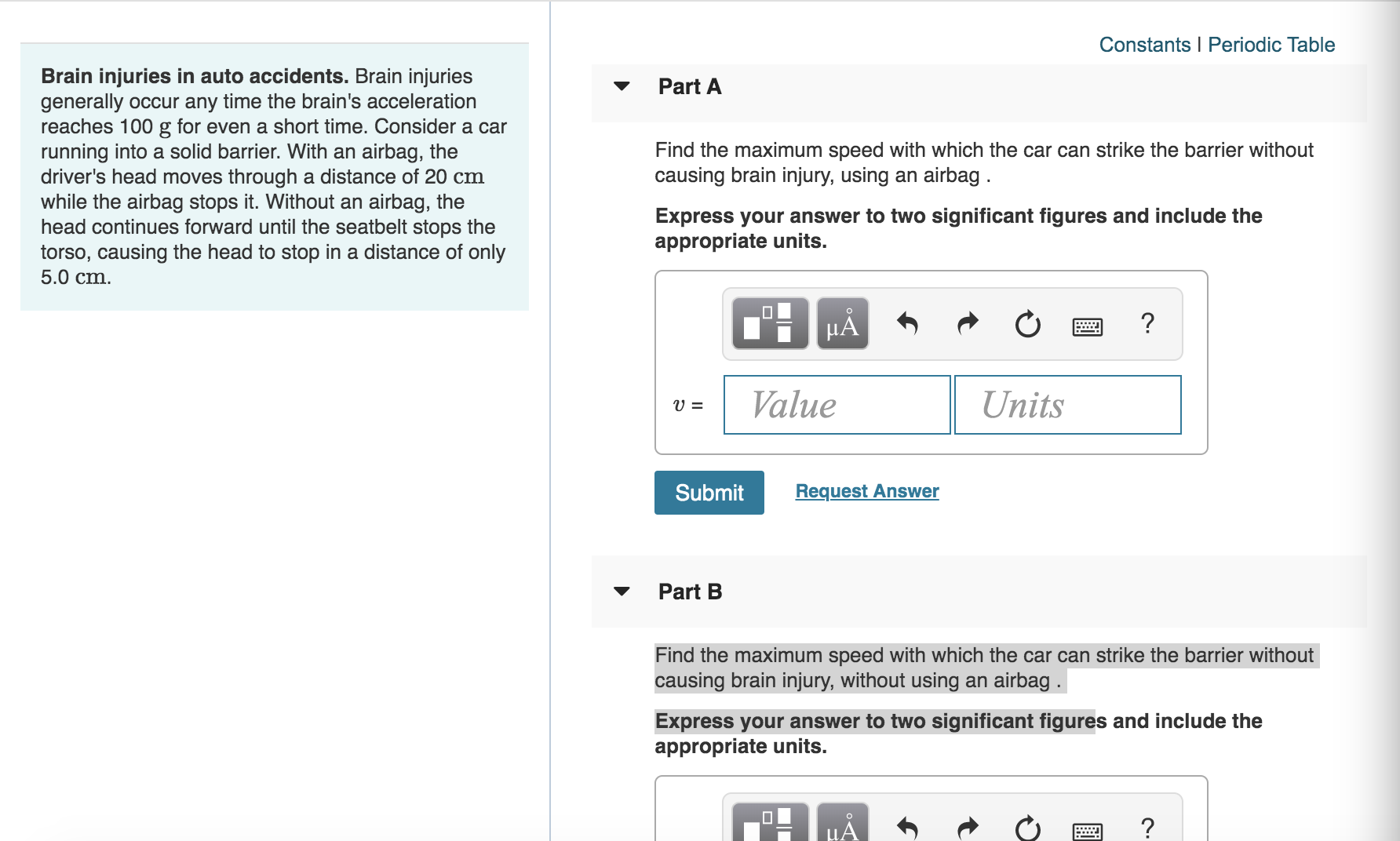Constants I Periodic Table Brain injuries in auto accidents. Brain injuries generally occur any time the brain's acceleration reaches 100 g for even a short time. Consider a car running into a solid barrier. With an airbag, the driver's head moves through a distance of 20 cm while the airbag stops it. Without an head continues forward until the seatbelt stops the torso, causing the head to stop in a distance of only 5.0 cm. Part A Find the maximum speed with which the car can strike the barrier without causing brain injury, using an airbag airbag, the Express your answer to two significant figures and include the appropriate units. ? HA Value Units Request Answer Submit Part B са Find the maximum speed with which the car can strike the barrier without causing brain injury, without using an airbag Express your answer to two significant figures and include the appropriate units. PHA ?
Constants I Periodic Table Brain injuries in auto accidents. Brain injuries generally occur any time the brain's acceleration reaches 100 g for even a short time. Consider a car running into a solid barrier. With an airbag, the driver's head moves through a distance of 20 cm while the airbag stops it. Without an head continues forward until the seatbelt stops the torso, causing the head to stop in a distance of only 5.0 cm. Part A Find the maximum speed with which the car can strike the barrier without causing brain injury, using an airbag airbag, the Express your answer to two significant figures and include the appropriate units. ? HA Value Units Request Answer Submit Part B са Find the maximum speed with which the car can strike the barrier without causing brain injury, without using an airbag Express your answer to two significant figures and include the appropriate units. PHA ?
Physics for Scientists and Engineers: Foundations and Connections
1st Edition
ISBN:9781133939146
Author:Katz, Debora M.
Publisher:Katz, Debora M.
Chapter2: One Dimensional Motion
Section: Chapter Questions
Problem 67PQ: While strolling downtown on a Saturday Afternoon, you stumble across an old car show. As you are...
Related questions
Question

Transcribed Image Text:Constants I Periodic Table
Brain injuries in auto accidents. Brain injuries
generally occur any time the brain's acceleration
reaches 100 g for even a short time. Consider a car
running into a solid barrier. With an airbag, the
driver's head moves through a distance of 20 cm
while the airbag stops it. Without an
head continues forward until the seatbelt stops the
torso, causing the head to stop in a distance of only
5.0 cm.
Part A
Find the maximum speed with which the car can strike the barrier without
causing brain injury, using an
airbag
airbag, the
Express your answer to two significant figures and include the
appropriate units.
?
HA
Value
Units
Request Answer
Submit
Part B
са
Find the maximum speed with which the car can strike the barrier without
causing brain injury, without using an airbag
Express your answer to two significant figures and include the
appropriate units.
PHA
?
Expert Solution
This question has been solved!
Explore an expertly crafted, step-by-step solution for a thorough understanding of key concepts.
This is a popular solution!
Trending now
This is a popular solution!
Step by step
Solved in 4 steps

Recommended textbooks for you

Physics for Scientists and Engineers: Foundations…
Physics
ISBN:
9781133939146
Author:
Katz, Debora M.
Publisher:
Cengage Learning

College Physics
Physics
ISBN:
9781285737027
Author:
Raymond A. Serway, Chris Vuille
Publisher:
Cengage Learning

Physics for Scientists and Engineers, Technology …
Physics
ISBN:
9781305116399
Author:
Raymond A. Serway, John W. Jewett
Publisher:
Cengage Learning

Physics for Scientists and Engineers: Foundations…
Physics
ISBN:
9781133939146
Author:
Katz, Debora M.
Publisher:
Cengage Learning

College Physics
Physics
ISBN:
9781285737027
Author:
Raymond A. Serway, Chris Vuille
Publisher:
Cengage Learning

Physics for Scientists and Engineers, Technology …
Physics
ISBN:
9781305116399
Author:
Raymond A. Serway, John W. Jewett
Publisher:
Cengage Learning

College Physics
Physics
ISBN:
9781305952300
Author:
Raymond A. Serway, Chris Vuille
Publisher:
Cengage Learning

College Physics
Physics
ISBN:
9781938168000
Author:
Paul Peter Urone, Roger Hinrichs
Publisher:
OpenStax College

Principles of Physics: A Calculus-Based Text
Physics
ISBN:
9781133104261
Author:
Raymond A. Serway, John W. Jewett
Publisher:
Cengage Learning